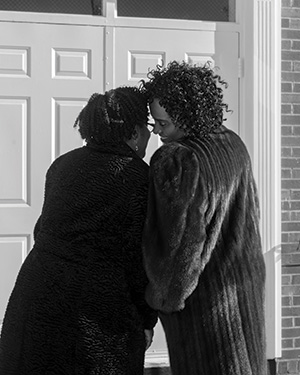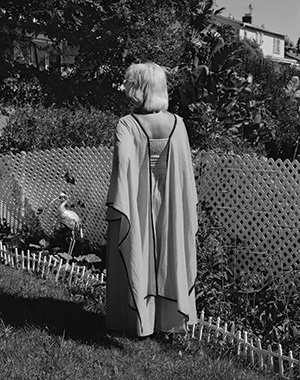Visions of Home
POSTED ON: April 16, 2021

Memory has a curious way of holding onto small details. In the photography of Dannielle Bowman, a 2011 graduate of the School of Art, those details become a language through which to relate shared, often unspoken histories. Last spring, Bowman was awarded the 2020 Aperture Portfolio Prize for What Had Happened, a series in progress that explores themes of home, family, and collective memory through striking black-and-white compositions photographed in the Los Angeles neighborhoods around where she grew up—Baldwin Hills, Inglewoood, and Crenshaw. The series has since expanded to include works produced in New Jersey; New Haven, Connecticut; and Bed-Stuy, Brooklyn and was presented by Aperture this past January in an exhibition titled Dannielle Bowman: 2020 Portfolio Prize Winner, hosted by Baxter St at the Camera Club of New York.
“Growing up in a neighborhood that has been so deeply shaped by migration is a unique experience,” says Bowman, whose grandfather moved to California from Texas at a young age. “I was interested in how recognizing cultural signifiers of that experience can make you feel comfortable, like you’re looking at your own family.” What Had Happened draws together associations of landscapes, cultural objects, and scenes of domestic life with alluring use of texture and shadow to evoke both personal memory and stories of Black American migration.
An important influence on this work, according to Bowman, is Isabel Wilkerson’s The Warmth of Other Suns, which traces the lives of four individuals to tell the story of the Great Migration, the movement of nearly six million African Americans out of the Southern United States between 1915 and 1970. “I became fascinated by the formal choices Wilkerson makes to see these individual stories within the context of the larger story, by looking at the intimate, micro-level events of personal family history as part of this macro-scale migration.” Yet What Had Happened is not conventionally documentarian, avoiding a focus on any one particular individual or family and often obscuring subjects’ faces from view. Bowman says she is instead drawn to black-and-white photography’s power to “shows us things in a way that we can’t actually see in our experience of the world. Like they’re from another place.”
In works such as Vision (Bump’N’Curl) (2019), which depicts a kaftan-clad woman in a lush backyard garden, that interweaving of estranged perspective and memory is anchored in the significance of detail. “We can never remember things 100%, and instead we remember the oddest details,” Bowman says. “The way her tomato plants smell in June, her hair. You remember those things, and that’s also part of the reason she’s turned away. She has this very specific hairstyle that speaks to a certain kind of Black glamour, and it reminds me of women in my family and many women I’ve met in my life.”

Working in the medium of black and white has also produced responses the artist had not quite anticipated: “In spite of the fact that the people in every other picture in the show are Black, people would assume that this woman in the garden is not a Black woman. I don’t know if it’s because they don’t expect a Black woman to be in that space, but it’s shown me how black and white photos really allow you to project onto what you’re seeing.”
Bowman, who earned her MFA from Yale School of Art and lives in New York City, has been a contributor to The New York Times 1619 Project, a journalistic endeavor to center North American slavery and the contributions of African Americans in the narrative of United States history. This year, she will participate in the Light Work Artist-In-Residence program, which is being hosted remotely as a result of COVID-19.
Like many artists, Bowman has had to alter her practice as a result of the pandemic: “I’ve wanted to work with archival material for a long time, but I also wanted a clear reason for doing it.” Last summer, she uncovered a hard drive of old photos taken at a 2012 family reunion in Texas. “They were incredible, so different from what I had been showing in critiques at Cooper, so much more fluid. I started pairing them with what I’m working on now and thinking about their relationship to these ideas of Black home and family.” Three of the photos, depicting this family celebration through a hazy lens, were displayed as part of the exhibition at Baxter St.
As a series, What Had Happened continues to evolve. “I see my approach to photography as a way of being in the world or seeing the world, and as a way of making worlds as opposed to being just about making projects,” Bowman says. That attachment to the medium dates to her time at Cooper, but learning to feel at home in her work has been a journey. “I was the most boring Cooper student ever. I wanted to take pictures and was really rigid about it. Now I beat myself up about not pushing myself more to try other mediums. I would mostly do environmental portraits. It took me a long time to figure out how to make work that I really care about, and it’s funny, because at the end of the day I’m basically still doing environmental portraits.”




